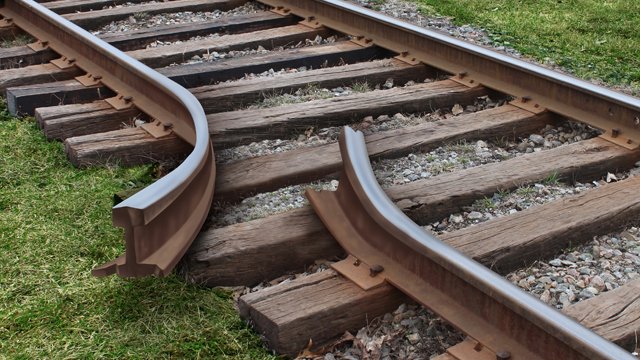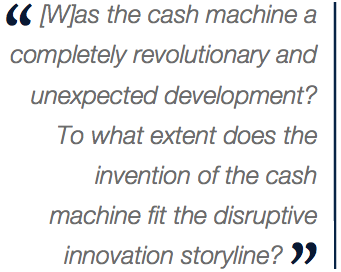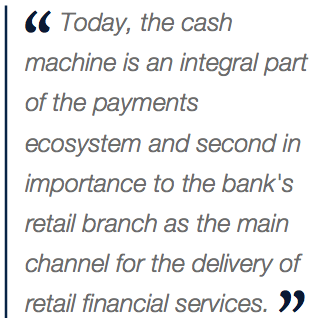Loading...
News

Was the ATM a disruptive innovation?
Wednesday, December 07, 2016
View Showroom
by Bernardo Batiz-Lazo on ATMmarketplace.com
During the last two or three years I have addressed and taken part in a number of industry forums, conferences and webinars. All of these are great opportunities to keep my research relevant as well as to meet and greet very interesting people that I would not otherwise have the possibility to talk to.
When mingling with the crowd at these meetings, I am often questioned (usually by someone at a fintech start up, but by radio talk show hosts as well) about the technology that I think will disrupt retail payments (and specifically put cash to bed for good).
The success of the iPhone and iPad usually frame the query as they are perceived to have disrupted mobile phones and tablets. This repeated comparison got me thinking whether, when first deployed, cash machines were a disruptive technology.
Disruptive innovation is a term coined in 1997 by Clayton M. Christensen of Harvard Business School in his first book "The Innovator's Dilemma." Christensen followed on the steps of Joseph Schumpeter to explain how improvements in a product or service turn out to dominate, in a way that is not expected by other market participants when first launched.
My favorite example is of Microsoft Encarta dislodging the 200 year old business model of Encyclopedia Britannica. The story goes more or less like this:
Prior to deciding whether to invest in developing a CD ROM version, Encyclopedia Britannica directors surveyed customers about their use of personal computers. At the time (early-to-mid 1980s), personal computers were just becoming popular and few customers were said to have one. Consequently Encyclopedia Britannica didn't develop a CD ROM.
Shortly after, the company was facing bankruptcy as — in spite of its lower-quality content — Encarta had taken over the market. Microsoft gave away Encarta for free and very few people were willing to pay for a full, paper-based encyclopedia set.
The Encyclopedia Britannica vs. Encarta story would tell us that sometimes even asking customers is little protection against disruptive innovation. One of Christensen's key insights is how to deal with potential disrupters, given that for every industry there is a host of potential technologies and it is financially impossible to invest in all of them.
Recently Christensen's ideas have been subject to criticism. This is not news to any academic-cum-consultant. But it seems a dent has been made. Big blows have been scored by Harvard historian Jill Lepore in the New Yorker as well as by evidence collected by other academics and published in the MIT Sloan Review (you can find all the links and more in Lee Vinsel's Taming the American Idol blog).
One of Lepore's arguments is that Chrisensen's sample companies do not behaved as his theory predicts in the long term. In our example, this is the case.
Some 30 years after the Encyclopedia Britannica vs. Encarta supposed disruption, Encyclopedia Britannica still remains in business (though primarily as a Web service and much reduced in size and profitability). Encarta is no longer with us as, in an apparent "race to the bottom," the rise of Wikipedia led Microsoft to bury Encarta for good in 2009. Christensen would probably retort that disrupters can be disrupted. For me, though, this is a circular argument.
 But giving Christensen the benefit of the doubt — and for what it's worth — was the cash machine a completely revolutionary and unexpected development? To what extent does the invention of the cash machine fit the disruptive innovation storyline?
But giving Christensen the benefit of the doubt — and for what it's worth — was the cash machine a completely revolutionary and unexpected development? To what extent does the invention of the cash machine fit the disruptive innovation storyline?Let me clarify. The term "cash machine" for me signals the predecessor to the ATM. I have written about it at length here and here. But in a nutshell, a cash machine is a stand-alone device that requires human intervention while the ATM is effectively a remote terminal of a bank's computer network. It took about two decades for the cash machine to transform into the ATM.
Now a first piece of evidence in the invention of the cash machine is that its conception was a response by incumbents to social change: As incomes in Europe grew there was a greater demand for leisure activities; the five day working week became the norm; labor became dear and more active and organized as unions demanded Saturday closing.
During my research into the matter, I found evidence that British and Swedish bankers responded to these changes by instructing engineers to build an apparatus that provided retail customers with access to cash after banking hours. Moreover, during interviews, some of the engineers said they were mostly ignorant of other outfits working toward the same goal.
Surviving evidence plays a picture of a coordinated effort from within the industry. Cash machines thus originated as an "inside out" development by incumbents as opposed to an "outside in" effort by a new or potential entrant, as in the Encyclopedia Britannica vs. Encarta example above.
Moreover, the cash machine results from efforts by a network of actors (comprised of bankers and engineers). This contravenes the picture of the lone inventor (regardless of whether his name is Goodfellow, Sheppard-Barron, Simjian or Witzel), as is, indeed, implicit in what has been widely disseminated throughout the Internet.
A second piece of evidence is that banks were not as secretive about the invention as it might otherwise appear. As early as October 1965 — or almost two years before the deployment at Barclay's Enfield branch — both the Times (1) and the Financial Times (2) broke the news that banks were in the process of developing "automatic machines [that will be] giving cash at any time." Both news items promised that the machines would be ready in 18 months' time in Britain. Neither of them mentioned developments in Sweden.
Interestingly, the scoop was claimed by the City (i.e., London financial district) editor of the Times, and by the "scientific correspondent" at the Financial Times. There are some inconsistencies within these early reports, however. For instance, both articles seem to describe the De La Rue Automatic Cash System, or DACS, a system that operated with "magnetic ink vouchers" and was sold exclusively to Barclays in the U.K.
However, at the same time, the Financial Times tells of "punched cards" that would be returned by post. This was the token system adopted by the Chubb machine deployed by the Westminster Bank (today NatWest, part of RBS Group).
Both reporters also describe a form of personal identification, as they state that "[a]s an additional security ... the customer may have to use a special key to identify him (sic) as the real purchaser ... "
Another inconsistency is that the Financial Times states that Midland Bank (today part of HSBC) was "understood to be discussing the problem with NCR."
This is odd because there was no record of these discussions within the historical archive; NCR did not develop a cash machine until the mid-1970s and the main provider of computer equipment to Midland Bank was Burroughs (who ultimately developed the devices that Midland and the Trustee Savings Banks would adopt).
Only the Financial Times followed up the story of the machines "developed for installation in the walls of banks" by describing and specifically naming De La Rue in March 1967 (3) and, more importantly, by showing a picture of the Chubb fascia side-by-side with that of the DACS in May of 1967 (4).
In other words, the general public was aware of the looks of a cash machine at least a month before the June 27, 1967 launch of the DACS in Barclays's Enfield.
This was due not only to reports in the broadsheets but also to the distribution of brochures and verbal information at the branches. Retail banking customers had to be taught how to operate the new devices, and had to apply in advance for either activation vouchers or plastic punched cards (as appropriate).
A third piece of evidence is that it took some 10 to 15 years for banks to deploy cash machines in double- or triple-digit quantities. This had to do in part with the need to make the machine work whatever the weather (a small fault in one of the early devices would shut it down altogether).
 Additionally, wider distribution had to wait until banks were able to digitalize the rest of the their operation; also cash machines had to compete with other alternatives for financial services delivery such as drive up windows, telephone banking, and other methods that we hardly even remember (such as the Mintel system in France).
Additionally, wider distribution had to wait until banks were able to digitalize the rest of the their operation; also cash machines had to compete with other alternatives for financial services delivery such as drive up windows, telephone banking, and other methods that we hardly even remember (such as the Mintel system in France).In summary, almost 50 years to the date after the first published report of its existence, the cash machine is now ubiquitous. Although the device has been instrumental in the way we access our cash, we can't really say that it was a disruptive technology when it was first launched. Nevertheless, for many decades it has been the main provider not only of cash at home and abroad, but also of other relevant and timely financial information (such as account balances).
Today, the cash machine is an integral part of the payments ecosystem and second in importance to the bank's retail branch as the main channel for the delivery of retail financial services. So taking the long-term view, it would seem that the cash machine did disrupt retail payments, after all.
1) "Cash at any time plan by bank. Wall machines to scan vouchers." The Times, Oct. 9, 1965.
2) "Round-the-clock banking robot cashier plan," Financial Times Oct. 11, 1965.
3) "More cash dispensers for leading banks," Financial Times March 22, 1967.
4) Pringle, Robin "New Drive in Banking," Financial Times May 22, 1967.
photo istock
Additional Resources from ATM Industry Association
- 5/16/2024 - Is Anyone Else Confused About TR-31? You're Not Alone!
- 5/16/2024 - ATMIA Europe Keynote: Martin Quinn Examines the Future of Cash in the UK
- 5/16/2024 - Embracing Cash: The Surprising Trend Among Millennials and Gen Z
- 5/15/2024 - Upcoming Committee Meetings May – June
- 5/15/2024 - Cashless Ban'd Wagon Update
- Show All ATM Industry Association Press Releases / Blog Posts


























